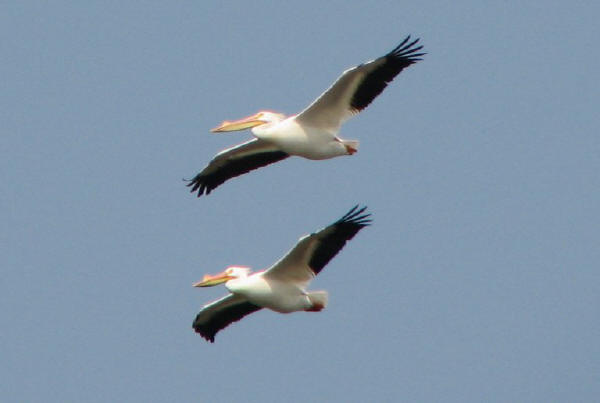|
American White Pelicans have been stopping at Nelson Lake Marsh/Dick Young Forest Preserve on their spring migration for at least 5 years now. Each year their numbers grow and each year their arrival date is earlier. (4/1, 3/29, 3/25, 3/23 over that last four years.) American White Pelicans are large birds. According to bird expert David Sibley, they have a 108" wing span. In comparison, the Bald Eagle has an 80" wingspan. Unlike the smaller Brown Pelican, the American White does not dive into the water to catch fish. Typically Whites feed as a group, swimming and herding fish into their submerged, gaping beaks. These huge birds also frequently fly as a group, exhibiting formation flying reminiscent of military show teams. The fibrous growth on the top of the beak, evident in the pictures below, is only present during breeding season. For those who traveled to Nelson Lake to view the pelicans late in the first week of April and were disappointed: On Wednesday, April 2nd, with 115 pelicans on the lake, the forest preserve district conducted a burn. With winds out of the southeast they burned essentially all of the eastern shore of the lake. The next day at noon, there were two pelicans left on the lake. The following day at 2 PM, there were none. In an interview with the Kane County Chronicle, Drew Ullberg, director of natural resources for the forest preserve, denied the forest preserve's burn played a role in the departure of the pelicans. He suggested that weather factors caused the birds to leave en masse. Fortunately about 75 new birds arrived from the south before the start of Kane County Audubon's "Scope Day" on Saturday, April 5th. Birding enthusiasts, whose cars overflowed the parking lots, were treated to the sight of these flying beauties. Please enjoy these photos of this year's migrants. (Photos of the 2007 pelicans can be seen here.) |
|
|
|
Some of this year's more than 100 American White Pelicans sunning and grooming on a spit of land at Nelson Lake. Note their size in relation to the the Canada Geese and American Coots. Photo courtesy Chuck Peterson. |
|
Photo courtesy Scott Seifrid |
 |
|
Photo courtesy Dennis Walz |
 |
|
Photo courtesy Ron Dickenson |
|
|
|
Photo courtesy Scott Seifrid |
.jpg) |
|
Photo courtesy Ron Dickenson |
|
|
|
Photo courtesy Scott Seifrid |
.jpg) |
|
Photo courtesy Ron Dickenson |
